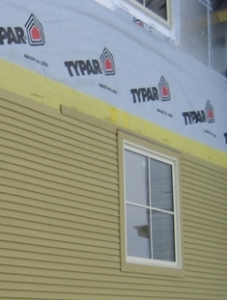Mar 5 2011
The team of building professionals who created Vermont’s first LEED for Homes Platinum-certified home agreed from the design stage that a rainscreen system would play an integral role in extending the life of the residence’s exterior siding.
The home’s design included the incorporation of a nylon matrix rolled rainscreen product called Home Slicker ® that was applied behind the cedar clapboard that covered much of the home’s exterior. It provides a space for continuous airflow between the clapboard and the water resistive barrier that covered the tightly sealed super-insulated building envelope.
 The yellow nylon material shown protruding above the cedar clapboard of the Pill-Maharam is Home Slicker ®, a rainscreen component which provides space for continuous airflow between the siding and water resistive barrier shown in white.
The yellow nylon material shown protruding above the cedar clapboard of the Pill-Maharam is Home Slicker ®, a rainscreen component which provides space for continuous airflow between the siding and water resistive barrier shown in white.
David Pill, AIA, an architect with Pill-Maharam Architects in Shelburne, VT, was intent on designing a home for his family that would have as little environmental impact as possible, while incorporating construction details that he could use in other projects. “This was actually one of the first opportunities I had to use a rainscreen system in one of my projects,” Pill said. “I wanted a product that would allow us to create a drainage plane behind the siding that promoted air circulation.”
He said he chose Benjamin Obdyke’s Home Slicker – rather than installing a more labor-intensive series of furring strips behind the siding – because the product could create the necessary space without adding additional thickness to the siding assembly. The airspace reduces the forces that might draw water into the wall assembly, while any water that does reach the back of the cladding can more easily drain. It also helps accelerate the drying of moisture-laden air that can accumulate in the interior wall assembly by moving air throughout the cavity.
“I think it’s really important to have that space behind any wood product, such as the wood clapboard I have on my home,” Pill noted. In addition to the LEED award, his 2,800-sq.-ft. home earned the Energy Star 5+ star rating and the AIA Vermont Honor Award in the House/Sustainable category, among many other awards. In the cold climate of Vermont, the net zero-energy home – with a renewable energy source of a wind turbine – produces as much energy as it uses.
Pill made the decision to include rainscreen technology in his home while collaborating with custom builder Jim Huntington of New England Housewrights and Andy Shapiro, an energy consultant with Energy Balance Inc. “Every decision we made would have implications later in the process. I knew a rainscreen system would definitely improve the durability of the siding in the years ahead,” Pill said. Shapiro noted that he is an advocate of adding an airspace behind siding. “I incorporate venting behind siding where I can,” he said. “It extends the life of the finish on the siding and extends the life of the siding itself.”
Builder Huntington was fully supportive when the rainscreen system was spec’d by Pill and Shapiro. “It was a great experience for me as a builder to have an owner who was willing to incorporate so many energy-efficient methods and products into their home. We took our time to make sure every detail was right,” he said. Pill made it clear from the beginning that he wanted to put as much of his efforts on the home’s shell as possible. The sidewall system includes studs insulated with closed-cell polyurethane spray foam, polyisocyanurate foam board over exterior sheathing, housewrap, Home Slicker, and painted cedar clapboard combined with corrugated metal exterior cladding.
“When it came time to add a rainscreen space behind the cedar clapboard, the Home Slicker was the way to go,” Huntington said. “It gives the siding a chance to dry out if any wind-driven moisture should get behind it.” The builder thinks the minimal additional expense of including a rainscreen component can be well worth it in the long-term. He noted that he routinely specifies Benjamin Obdyke’s Cedar Breather®, a moisture-management product similar to Home Slicker, with cedar shake and shingle roofs. “I know the roofs have to breathe. It’s a must for me.”
Since the Pill-Maharam home was completed, it has delivered on everyone’s expectations. The turbine has produced enough energy for the home’s needs and the high-efficiency design has kept the family comfortable in the cold winters and the warm summers. “I also made the right decision to include the rainscreen system in our home and I’ve incorporated the technology into the recommendations of other homes I’ve designed. The process has been a fantastic learning experience for me,” Pill said.
Source: http://www.benjaminobdyke.com/